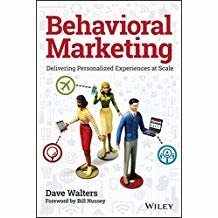 The next book is another in my marketing theme How Brands Grow: What Marketers Don’t Know by Bryon Sharp. The core message of the book is that marketers have a lot of wrong ideas and empirical, scientific research can disabuse them of these notions, Sharp terms this new world “evidence-based marketing”.
The next book is another in my marketing theme How Brands Grow: What Marketers Don’t Know by Bryon Sharp. The core message of the book is that marketers have a lot of wrong ideas and empirical, scientific research can disabuse them of these notions, Sharp terms this new world “evidence-based marketing”.
I see a pattern in the form of the marketing books I have read: they both started with short form summaries of the main conclusions of the book. In Behavioural Marketing these were tweet sized chunks. In this book they are a set of laws: double jeopardy law, law of buyer moderation, natural monopoly law. The chapters discuss each of the laws in turn. The conclusion repeats these laws. It follows the scheme my PhD supervisor taught me for academic presentation “tell them what you’re going to tell them, tell them, tell them what you told them”.
Sharp, who authors most of the chapters, works at the Ehrenberg-Bass Institute, perhaps it is following his own marketing advice but this seems to get mentioned in every chapter, several times.
The core of the laws is that much of the observed outcomes of brand performance really just come down to brand penetration (the share of the market that a brand has in terms of the number of customers and the frequency of purchase), and the essentially random behaviour of consumers. Loyalty to a brand is a bit of an apparition, brands maintain their position not because the same people buy from them repeatedly through loyalty but because consumers move from brand to brand somewhat at random but biased by the market share of a brand. So big brands gain and lose customers from sale to sale in greater numbers than small brands but as a proportion they do slightly better than small brands because an infrequent customer is more likely stumble on a big brand than a small one.
A second important feature is the distribution of buyer frequency. There are few frequent buyers of any brand, the shopper that buys Coca Cola 3 times a day, but there are many infrequent buyers – someone who buys Coca Cola a couple of times a year. Most brands have a distribution of consumers where the top 20% contribution at best half or so of the sales of the brand. This is rather less than the 80/20 Pareto law. It means that the long tail of infrequent buyers is important. Sharp is keen on citing the negative binomial distribution (NBD)-Dirichlet theory. It strikes me this isn’t a theory, it is a description of a distribution, the features of this distribution can be used to explain observed market behaviour.
Sharps conclusions on acquisition and retention are interesting, he argues that brands grow by acquisition rather than reduced retention. All brands lose some customers to their rivals at each purchase but acquisition and loss are generally proportional to the market share.
What surprised me was that even for brands with famous brand loyalty such as Apple, the degree to which “Apple buyers” buy other brands of computer is quite high i.e. 50% or so. And there aren’t really brand demographics, except in extreme cases such as rich people buying expensive items, and children watching children’s TV. There isn’t a “Ford buying demographic” and a “Renault demographic”. It isn’t even that there are generally customers committed to a particular price point, customers buying a premium brand are quite likely to buy a bargain brand as their next purchase. Niche brands turn out to be just a polite way of saying small.
Fundamental to all of this is that consumers care a whole lot less about brands, and their differentiating features, than you, the marketer, ever will. As consumers we just don’t care. And so the role of advertising is to shift the needle in terms of simple recognition. When it comes to my desire to buy a brown, sweet fizzy liquid to drink the special features of a particular brand are unimportant, the image a brand tries to project about itself is unimportant, the special demographic the brand tries to hit is unimportant. All that is important is that I remember the brand, the packaging and that it is on hand when I make my occasional decision to buy a brown, sweet fizzy liquid.
This seems to go against the idea of behavioural or targeted marketing, although perhaps the distinction is that the “bad” targeted marketing is based on demographics, age or gender, whilst the “good” targeted marketing is based on behaviour, abandoned baskets or opened emails.
I enjoyed this second foray into marketing, How Brands Grow is well-structured and relatively easy reading. I found the ideas it contained intriguing and the methodology is in tune with my background as a physical scientist.

